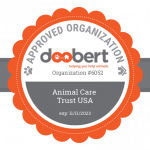GET INVOLVED TO SAVE ANIMALS!
 “Today’s guest was Kim Pruett. Kim is a “retired” rescuer and self-made animal advocate. Kim’s life changed in a big way about fifteen years ago when she adopted her dog Rebel (now 15) from a shelter. Before that, Kim didn’t know that animal shelters euthanized healthy, adoptable pets. Since then, she has been speaking up on behalf of animals everywhere!
“Today’s guest was Kim Pruett. Kim is a “retired” rescuer and self-made animal advocate. Kim’s life changed in a big way about fifteen years ago when she adopted her dog Rebel (now 15) from a shelter. Before that, Kim didn’t know that animal shelters euthanized healthy, adoptable pets. Since then, she has been speaking up on behalf of animals everywhere!
Kim is passionate about all things pets. Today’s show focused on a couple of her current concerns. We learned about the 12 steps to becoming a “no kill” shelter. Defined, a no kill shelter is one that does not kill healthy or treatable animals even whent eh shelter is full. Euthanasia is reserved for terminally ill animals or those that are considered dangerous to the public safety.
Here are the 12 steps:
- Feral Cat TNR (Trap, Neuter, Release) Programs. Communities that embrace TNR have a lower kill level because feral cats are neutered and then returned to their colonies instead of being euthanized.
- Comprehensive Adoption Programs. Most shelters are not welcoming adoption centers but instead are cold, inhospitabble holding facilities. Studies show that people get their pets from shelters only 20% of the time. We need to change these numbers. Let’s adopt the motto, “Until there are none, adopt one!”
- Low Cost Spay and Neuter programs. These programs will lead to fewer unwanted animals entering the shelter system. Fewer animals coming in means more animals getting a chance at adoption and a forever home.
- Rescue Groups. Developing a working relationship with local rescue organizations and breed specific rescues helps to free up shelter space, reduces expenses for feeding, cleaning and ultimately, killing.
- Social Media. Use the power of social media to let rescue groups, animal advocates and the public know about animals that need to find homes.
- Foster Care Programs. Volunteer foster care is critical to lowering euthanasia rates. It is low cost or no cost and increases the capacity of a shelter to take more pets, improves public relations, enhances public perception and allows for the rehabilitation of sick, injured or behaviorally challenged animals. Many shelters and rescue organizations have adopted, “Take a Dog to Lunch” or “Foster for a Weekend” type programs. Foster programs increase the probabability of an animal finding its forever home.
- Rehabilitation Programs – Medical and Behavioral. Shelters who have behavioral trainers on staff and who implement comprehensive vaccine, handling and socialization programs have higher adoption rates. A shelter is a scary place for many animals who just need an opportunity to find their forever home.
- Public Relations/Community Involvement. A shelters public image is important to its success and its survival. Good, consistent marketing and public relations is crucial.
- Volunteers. These people are the backbone of every successful no kill effort. There is never enough staff, never enough money to hire more staff and always more to do than there are hours in the day.
- Proactive Redemptions. This means getting strays or lost pets back to their owners before they ever get to the shelter. A shift from a passive to an active approach to getting pets back to their owners is a first step.
- Pet Retention through Community Education. Shelters need to work with pet owners to educate them about how to keep their pets, not surrender them. Responsible pet ownership programs and behavioral training programs are just a few ways to accomplish this goal.
- Leadership. A strong, proactive and compassionate leader is an absolute must.
Kim was also passionate about eliminating “pet mills” or “puppy mills” – establishments that exist for only one reason, to supply puppies, kittens and rabbits to the retail pet industry. If you buy a puppy from a puppy store, almost without exception it will be from a puppy mill. These breeder animals live in desperation. They never experience love, a home, proper veterinary care and healthy food and water. They don’t have exercise or toys or sleep in a warm bed. They exist for only one reason, to produce more babies. When they can no longer produce, they are no longer wanted. Encourage your community and your state to ban the retail sale of dogs, cats and rabbits.
Get involved with your County Commission. Get some friends and make your voices heard. Get access to public documents. Demand accountability. Get your state and county officials to do the right things for animals – always.
Encourage your officials to adopt a state wide animal abuse registry. The link between animal abuse and domestic violence is well documented. Let’s make the identities of these abusers known so they won’t be allowed to own or adopt pets. You can learn more by clicking on the picture of Molly below – she’s a survivor and the Ambassador for Marion County, Florida’s Animal Abuse Registry.


